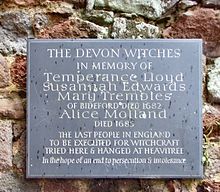Witch trials in England



The Witch trials in England were conducted from the 15th century until the 18th century. They are estimated to have resulted in the death of between 500 and 1000 people, 90 percent of whom were women. The witch hunt was as its most intense stage during the English Civil War (1642–1651) and the Puritan era of the mid 17th century.[1]
History
Chronology
Witch trials are known to have occurred in England during the Middle Ages. These cases were few, and mainly concerned cases toward people of the elite or with ties to the elite, often with a political purpose.[2] Examples of these were the trials against Eleanor Cobham and Margery Jourdemayne in 1441, which resulted in lifetime imprisonment for the former, and an execution for heresy for the latter.
It was however not until the second half of the 16th-century that a widescale witch hunt took place in England. The cases became more common in the end of the 16th-century and the early 17th-century, particularly since the succession of James VI and I to the throne. King James had shown a great interest in witch trials since the Copenhagen witch trials in 1589, which had inspired the North Berwick witch trials in Scotland in 1590. When he succeeded to the English throne in 1603, he sharpened the English Witchcraft Act the following year.
Witch trials were most frequent in England in the first half of the 17th-century. They reached their most intense phase during the English civil war of the 1640s and the Puritan era of the 1650s. This was a period of intense witch hunts, known for witch hunters such as Matthew Hopkins.
Legal situation
The first Witchcraft Act in England was introduced in 1542. The Act was however repealed in 1547. The Witchcraft Act of 1563 introduced the death penalty for any sorcery used to cause someone's death. In 1604 the Witchcraft Act was reformed to include anyone to have made a Pact with Satan.
The witch trials
In England, it was not as common as in some other nations to be accused of having attended a Witches' Sabbath or having made a Pact with Satan.[1] The typical victim of an English witch trial was a poor old woman with a bad reputation, who were accused by her neighbors of having a familiar and of having injured or caused harm to other people's livestock by use of sorcery.[1]
About 500 people are estimated to have been executed for witchcraft in England.[3][2]
The end
After the many witch trials of the mid 17th century, the cases became fewer during the second half of the 17th-century. Mary Hicks and her daughter Elizabeth Hicks have been referred to as the last people executed for witchcraft in England in 1716.
Witch trials formally ended in England after the introduction of the Witchcraft Act of 1735.
Colonies
Witch trials occurred also in the English colonies, where English law was applied. This was particularly the case in The Thirteen Colonies in North America. Examples of these were the Connecticut Witch Trials. The most famous of these trials were the Salem witch trials in 1692.
See also
References
- ^ a b c Ankarloo, Bengt & Henningsen, Gustav (red.), Skrifter. Bd 13, Häxornas Europa 1400-1700: historiska och antropologiska studier, Nerenius & Santérus, Stockholm, 1987
- ^ a b William E. Burns: Witch Hunts in Europe and America: An Encyclopedia
- ^ Macfarlane, Alan; Sharpe, J.A. (1999). Witchcraft in Tudor and Stuart England : a regional and comparative study. Database:Taylor & Francis. pp. 62–63. ISBN 9780203063668.
- 15th-century establishments in England
- 1735 disestablishments in England
- Early Modern law
- Early Modern politics
- Legal history of England
- Political history of England
- Social history of England
- Trials in England
- Witchcraft in England
- 16th century in England
- 17th century in England
- 18th century in England
- Witch trials in England
